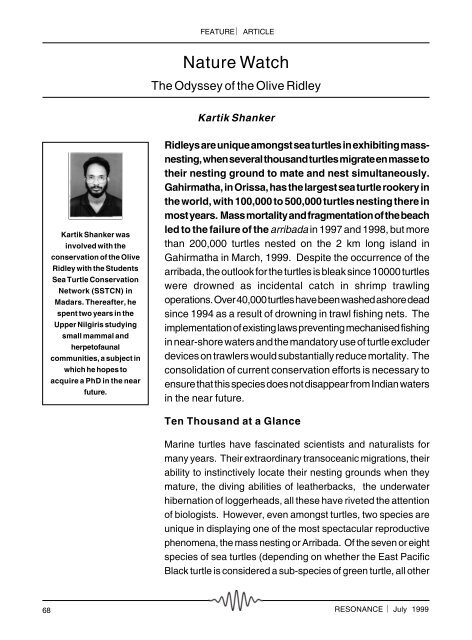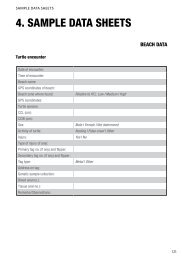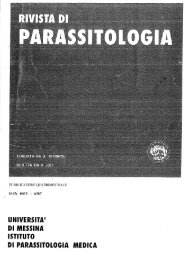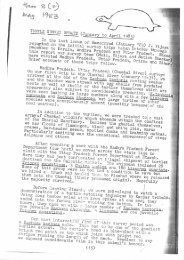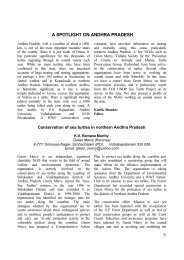You also want an ePaper? Increase the reach of your titles
YUMPU automatically turns print PDFs into web optimized ePapers that Google loves.
FEATURE ⎜ ARTICLE<strong>Nature</strong> <strong>Watch</strong>The Odyssey of the Olive RidleyKartik ShankerKartik Shanker wasinvolved with theconservation of the OliveRidley with the Students<strong>Sea</strong> Turtle ConservationNetwork (SSTCN) inMadars. Thereafter, hespent two years in theUpper Nilgiris studyingsmall mammal andherpetofaunalcommunities, a subject inwhich he hopes toacquire a PhD in the nearfuture.Ridleys are unique amongst sea turtles in exhibiting massnesting,when several thousand turtles migrate en masse totheir nesting ground to mate and nest simultaneously.Gahirmatha, in Orissa, has the largest sea turtle rookery inthe world, with 100,000 to 500,000 turtles nesting there inmost years. Mass mortality and fragmentation of the beachled to the failure of the arribada in 1997 and 1998, but morethan 200,000 turtles nested on the 2 km long island inGahirmatha in March, 1999. Despite the occurrence of thearribada, the outlook for the turtles is bleak since 10000 turtleswere drowned as incidental catch in shrimp trawlingoperations. Over 40,000 turtles have been washed ashore deadsince 1994 as a result of drowning in trawl fishing nets. Theimplementation of existing laws preventing mechanised fishingin near-shore waters and the mandatory use of turtle excluderdevices on trawlers would substantially reduce mortality. Theconsolidation of current conservation efforts is necessary toensure that this species does not disappear from <strong>India</strong>n watersin the near future.Ten Thousand at a GlanceMarine turtles have fascinated scientists and naturalists formany years. Their extraordinary transoceanic migrations, theirability to instinctively locate their nesting grounds when theymature, the diving abilities of leatherbacks, the underwaterhibernation of loggerheads, all these have riveted the attentionof biologists. However, even amongst turtles, two species areunique in displaying one of the most spectacular reproductivephenomena, the mass nesting or Arribada. <strong>Of</strong> the seven or eightspecies of sea turtles (depending on whether the East PacificBlack turtle is considered a sub-species of green turtle, all other68 RESONANCE ⎜ July 1999
FEATURE ⎜ ARTICLEMap 1species nest solitarily. The two species of Ridleys, the Kemp’sRidley which is found only on the east coast of Mexico, and theOlive Ridley, found worldwide, exhibit the phenomenon ofmass nesting (Figure 1). <strong>Of</strong> the two, the Kemp’s Ridley nestsonly in arribadas, the Rancho Nuevo in Mexico was and is theonly known nesting site for this species. It is also uniqueamongst turtles in that it nests during the day as a rule.The Olive Ridley (Lepidochelys olivacea) is one of the mostnumerous sea turtles thanks to the continued existence of a fewmass nesting sites. There are two sites in Pacific Costa Rica andone in Pacific Mexico. In <strong>India</strong>, there are three major massnestingsites of the Olive Ridley all on the east coast, in Orissa(Figure 2). The nesting site at Gahirmatha (a part of Bhitarkanikasanctuary) at the mount of the river Maipura near Dhamra, wasdiscovered by the scientific community in 1974, and is thelargest sea turtle rookery in the world with 100,000 to 500,000turtles nesting there each year. There are smaller rookeries atthe mouth of the Devi River (north of Puri) and Rushikulya inGanjam district in southern Orissa. This year, mass nesting hasbeen recorded at another site at Barunei mouth, about 30 kmFigure 1. A map showingthe nesting sites (circles)of the Olive Ridley in theworld and the only nestingsite of the Kemp’s Ridley(square). Apart fromOrissa, there are two majormass nesting sites in PacificCosta Rica and one inPacific Mexico. The arrowsindicate an evolutionarybiogeographic model inwhich the Olive Ridley mayhave spread westward fromthe Eastern Pacific regionthrough the <strong>India</strong>n Pacificregion and recently colonisedthe Atlantic ocean viasouthern Africa.RESONANCE ⎜ July 199969
FEATURE ⎜ ARTICLEFigure 2. A map of thenesting beaches of the OliveRidley in Orissa. Thenorthern most site isGahirmatha, with DeviRiver mouth in between andRushikulya to the south.Map 2Figure 3. The mass nesting(arribada) of Olive Ridleysat the Nasi island off theGahirmatha coast. Thoughmost sea turtles, with theexception of the Kemp’sRidley, nest during thenight, there was massnesting during much of theday for the first three daysduring the arribada this year(Kartik Shanker) .south of Gahirmatha (Figure 3). At the beginning of the 1999nesting season, local conservationists and researchers did notexpect that the arribada would take place this year, especially atGahirmatha. The arribada had failed two years in a row, whichhas not happened in the last twenty five years. Mass mortalityhad taken its toll of the population overthe past five years and the nesting beachwas unsuitable for nesting. The originalnesting beach at Gahirmatha was a 10 kmlong beach which was part of the mainland.In 1989, a cyclone caused a 4 km sand spitto separate from the mainland and becomean island. Since then the turtles havenested only on the island. In 1997, theisland further fragmented into two, both70 RESONANCE ⎜ July 1999
FEATURE ⎜ ARTICLEnow only about 100 metres wide (Figure 4), and turtlesnest predominantly on the northern fragment. Theislands are very close to the Wheeler islands, whichinclude the Outer Wheeler island, where the DefenceResearch and Development Organisation (DRDO)has its missile testing range in Long Wheeler island,where the Wildlife Institute of <strong>India</strong> has a sea turtleresearch station. Since the nesting islands (known asEkakulanasi 1 and 2) have become narrower over thepast few years, they are inundated by sea water duringspring tide and this renders them unsuitable fornesting.In the last week of March, however, the turtles suddenlybegan to strand on the beach. About fifty thousandturtles nested on each of the first two days. Massnesting occurred during the day and night over muchof the next ten days. It is estimated that 210,000 to250,000 turtles nested during this time. During thearribada, hundreds of turtles come ashore with everywave till there are thousands of turtles crawling aroundon the beach looking for a place to nest (Figure 5). Some willreturn to the water without nesting, not to come back later thatnight or after a few days. Other turtlesbegin to dig their nests, throwing sandover other turtles near them, and oftenthey are almost fully buried themselves bythe time they finish laying their eggs. Eachturtle digs a flaskshaped nest about a footand half deep, and lays 100 to 150 soft,ping pong ball sized eggs. More thanthirty million eggs are laid on the 2 kmlong island at Gahirmatha (Figure 6).Unfortunately, however, 80% of the eggsare lost over the next month due to floodingand erosion (Figure 7). Generally, the lossof eggs during an arribada is extremelyFigure 4. The nesting beach at Nasi 1,Gahirmatha. This is a fragment of theisland which originally broke awayfrom the mainland during a cyclonicstorm in 1989. The beach is likely toget further fragmented as sea waterhas formed an inlet and a small waterbody within the island (Kartik Shanker).Figure 5. Erosion of the beach creates variousproblems for turtles, including the formation ofsteep walls which the turtles struggle to climb whenthey come ashore to nest (Kartik Shanker).RESONANCE ⎜ July 199971
FEATURE ⎜ ARTICLEhigh. A fair number are predated, thoughthe proportion of eggs predated during anarribada may be less than that of solitarynesters, a possible explanation for thephenomenon of mass nesting. Latenesting turtles destroy some proportionof the eggs of early nesting turtles (Figure8). And of course, nests laid near the hightide line and shallow nests are exposedduring spring tides. Scientists have longFigure 6. Mass nesting at Nasi 2, Gahirmatha. Nesting debated the causes of the arribada.was very heavy on the first two days with about Though the ultimate cause is not known,50,000 turtles nesting during the day and nightthere are two theories for the proximate(Bikash Pandav).mechanism by which arribadas take place.One theory proposed that the turtles are triggered by an externalstimulus or stimuli which causes them to come ashore en masseFigure 7 (left). Bivash Pandav and a team of Wildlife Institute of <strong>India</strong> have been working on the seaturtles of Orissa since 1994. Research includes tagging and monitoring the turtles in off-shorewaters, studying the mating and nesting behaviour, and monitoring the nesting beaches on theOrissa coast (Kartik Shanker).Figure 8(right). Late nesting turtles dig up the nests of earlier turtles (Bivash Pandav) .72 RESONANCE ⎜ July 1999
FEATURE ⎜ ARTICLEand nest. It is true that, in Gahirmatha,arribadas occur during the third quarter ofthe moon and when there is a strong wind.Another theory suggests that there is socialfacilitation in the phenomenon, perhapsby chemical communication, supportedby the fact that Ridleys along amongstturtles have inframarginal pores. There,is, however, no conclusive proof that theycommunicate with each other. In fact,satellite telemetry studies show that Figure 9. <strong>Turtles</strong> mate in the off shore waters. Thefemales are not spatially associated during male mounts the female, holding her with the clawson his foreflippers, and the large claws on his hindinteresting period and aggregate onlyflipper, the female may receive bites to the neckduring mass nesting. The fluctuation inand flippers during this time, he then curls his longthe number of nesting turtles at the various tail to bring their cloaca into contact and erects hisnesting sites in Orissa, and nesting at new penis into her cloaca (Kartik Shanker) .site this year implies that turtles maychange sites if a particular beach becomes unsuitable for nesting.This contradicts the theory that sea turtles are very rigid aboutreturning to nest on their natal beach.A Transoceanic Life Cycle<strong>Sea</strong> turtles have separate feeding and breeding grounds. Thesemay be thousands of kilometres away from each other. Duringthe breeding season, they migrate to the breeding ground, mate(Figure 9) and then the females come ashore to nest. when theeggs hatch after 7 to 8 weeks, (sex is determined by incubationtemperature) the hatchlings emerge from the nest, usually atnight to avoid predators, locate the sea using the brighter horizon(moon and star light reflecting off the eater) and immediatelyhead back to the sea. As they reach the sea, they head out intothe open ocean by swimming perpendicularly to the wavedirection. At this time, they are also oriented to the earth’smagnetic field. Recent experiments have shown that turtles candetect the magnetic inclination angle and the magnetic fieldintensity and use these to navigate in the open ocean. Thehatchlings spend the next ten to fifteen years in seaweed raftsRESONANCE ⎜ July 199973
FEATURE ⎜ ARTICLEFigure 10. Two OliveRidleys return to the seaafter nesting (Kartik Shanker).and FADs (Fish Aggregating Devices)being carried around by transoceaniccurrents. Juvenile loggerheads from thenesting beaches of Japan may traverse theNorth Pacific during their developmentalmigration, a distance of over 10,000 kms.When the turtles mature, they return tothe feeding grounds to join the adultcolonies and then undertake their firstbreeding migration. Olive Ridleys (andleatherbacks) are open ocean feeders and do not have specificfeeding grounds. Several Olive Ridley females, which nested inthe arribada at Costa Rica, were tracked using satellite telemetryand were found to head in different directions into the Pacificafter they had finished nesting (Figure 10). Tags from turtlesthat nested on the Orissa coast have been recovered from SriLanka and Kerala, implying that they move south along the eastcoast and then fan out into the southern <strong>India</strong>n Ocean.<strong>Turtles</strong> face many natural predators; from the time the hatchlingleaves its nest and makes a dash for the sea. It falls prey to dogs,jackals and birds on the beach and then a host of marinecarnivores. In fact, only one in a thousand hatchlings survives toadulthood. <strong>Sea</strong> turtle populations grow very slowly, whichmeans that populations that are severely depleted by humanrelatedactivities, may take a very long time to recover. Over theyears, turtles have been heavily exploited for meat (mainlygreen turtles), tortoiseshell (Hawksbills) and eggs. They arealso adversely affected by loss of habitat due to developmentalactivities and increase in coastal habitation. Beach lightingposes a major problem because adults and hatchlings aredisoriented by artificial light and hatchlings are unable to findthe sea on emerging from the nest and so die of dessication orpredation in the morning.Travails of <strong>Turtles</strong> in OrissaWorldwide, shrimp trawling has been identified as the biggest74 RESONANCE ⎜ July 1999
FEATURE ⎜ ARTICLEcause of turtle mortality. Since the tradein turtle meat and products is bannedinternationally, they cannot be hunted.However, they are accidentally caught andkilled in shrimp fishing operations. In<strong>India</strong>, several thousand turtles werecaptured year after year off the coast ofOrissa and shipped to Calcutta to meet thedemand for meat till the 1970s. The oliveridley is classified in Schedule I of the<strong>India</strong>n Wildlife Protection Act (1972), and Figure 11. The mass mortality of Ridleys off thecoast of Orissa is mainly due to drowning in trawlthe imposition of the ban on turtle meatfishing nets. More than 40,000 turtles have beensubstantially reduced poaching. However,killed in the past five years and 10,000 turtles werein recent years, turtle mortalities have killed in 1999 (Kartik Shanker) .increased dramatically due to shrimptrawling (Figure 11). Frequently, ten or more sea turtles arecaught during a single trawling operation. Since 1994, morethan 40,000 turtles have died off the coast of Orissa due totrawling. Mortality reached a peak with 13,575 turtles washedashore in 1998 and about 10,000 turtles have already beenwashed ashore dead this year. Olive Ridleys can dive for aboutan hour under normal conditions, but trawl nets are operated forseveral hours and the stress of being trapped further decreasesthe turtle’s chance of survival.Even so, turtles drowned in trawl nets are usually in an anoxicstate and comatose, and will revive if they are kept out of waterin a cool place for a few hours. However, most trawler operatorsare unaware of this and even if they were aware, many mightsimply not be concerned enough to wait for turtles to revivebefore throwing them back into the water. The trawlers can alsominimise turtle mortality by using turtle ex-cluder devices(TEDs) which are trapdoors attached to the trawl net whichallow the turtles to escape from the trawl nets. However, none ofthe trawlers operating in Orissa now use TEDs because thefishermen believe that the TEDs cause loss of catch.<strong>Sea</strong> turtles also face other problems along the Orissa coast. TheyRESONANCE ⎜ July 199975
FEATURE ⎜ ARTICLEaccorded some legal status so that the nestingturtles there can also be protected.Monitoring these areas would also helpreduce hatchling mortality due to predationby dogs and jackals.The reduction in beach front lighting andthe introduction of controlled ‘turtle friendly’lights would greatly reduce hatchlingmortality. Over the past two years,organisations such as the Defence Researchand Development Organisation (DRDO) andchemical factories, which have been a majorsource of artificial light near mass-nestingbeaches, have been persuaded to turn offtheir lights during the nesting season. Thecooperation of such organisations and thepeople living along the coast is essential for the success of theconservation programme (Figure 13). In 1999, variousgovernment, non-government and research organisations havecome together to form a movement called Operation Kachhapawhich aims to monitor nesting and mortality on the coast,prevent trawling through patrolling and promote turtleconservation amongst the local people through education andawareness programmes. This is a conservation scenario wherethe local people do not have to be driven out to protect thespecies; in fact, supporting the cause of the traditional fisherfolkwould indirectly help the olive ridleys of the Orissa coast.Current and Future Research in Support ofConservationResearch on these turtles also gives us valuable informationwhich can help in formulating strategies for their conservationand management. Since sea turtles do not respect nationalboundaries, it often requires cooperation between severaldifferent governments and organisations working in differentcountries to effectively conserve and manage a sea turtleFigure 13. The lifestyle of the local fishing folk hasbeen impacted by the trawlers and developmentalactivity along the coast. Their concerns must alsobe addressed while seeking a solution to the problemof sea turtle conservation of the east coast (KartikShanker) .RESONANCE ⎜ July 199977
FEATURE ⎜ ARTICLEFigure 14. Bivash Pandavand a team of WildlifeInstitute of <strong>India</strong> have beenworking on the sea turtlesof Orissa since 1994.Research includes taggingand monitoring the turtlesin off-shore waters,studying the mating andnesting behaviour, andmonitoring the nestingbeaches on the Orissa coast(Kartik Shanker).population. However, one must firstidentify the turtle’s migration routes todetermine which areas the turtles use andwhere they are being exploited or killed.Bivash Pandav of the Wildlife Institute of<strong>India</strong> has tagged several thousand turtlesoff the Orissa coast (Figure 14). His taggingstudy has shown that the turtles swim southto the tip of the peninsula. More studiesusing satellite telemetry may be neededfurther to trace their migration route. Hisstudy also showed that the same turtles use different massnesting beaches for laying their eggs, and are not restricted to asingle site as it was earlier suspected. His tagging work onmating pairs provides insights into the reproductive behaviourof the species.Research on the population genetics of the species would giveinformation on the distinctiveness of the different populationsthat nest on the east coast and possibly on the origin of theturtles. Studies on the coastal geomorphology, which are inprogress, would be invaluable, considering the dynamic natureof the nesting beach. Conservation-oriented research would goa long way in supporting monitoring and education programmeto ensure the survival of the species.Suggested ReadingAddress for CorrespondenceKartik ShankerA1/4/4. 3rd Main RoadBesant NagarChennai 600 090, <strong>India</strong>.Email : kartik69@usa.net[1] Bivash Pandav B C Choudhury and C S Kar, Olive Ridley sea turtle(Lepidochelys olivacea) and its Nesting Habitats along the Orissa coast,<strong>India</strong>. A status survey, Wildlife Institute of <strong>India</strong>, Dehradun, <strong>India</strong>, 1997.[2] Peter L, Lutz and John A, Musick (Eds), The biology of sea turtles, CRCPress, Florida, USA, 1997.[3] Bivash Pandav, B C Choudhury and Kartik Shanker , The Olive Ridleysea turtle (Lepidochelys olivacea) in Orissa: An urgent call for an intensiveand integrated conservation programme, Current Science, 75 (12),1323–1328, 1998.78 RESONANCE ⎜ July 1999


